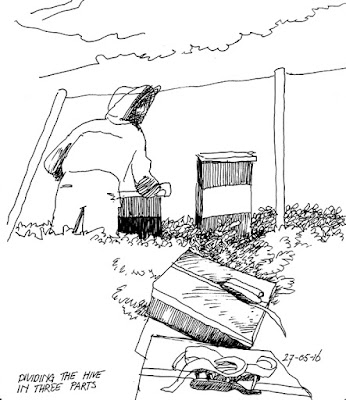Timothy Stevens the beekeeper came around do a very special procedure. I was quick with the sketchbook. Afterwards he send me this report: ‘Today I was looking after the beehives I have in achill both on the mainland and on the island. Peti Buchel drew some wonderful drawings of some of my activities today. I have a beehive located at her house. Since losses were so high this winter I have been doing a few splits. A split is where you break a hive into two or more pieces. In this case I broke the hive into 3 peices. 1/3 of the hive stayed at the apiary(bee yard) and the other 2 parts went to another apiary a few miles away. A hive of bees normaly only has one queen so when they are split like this 2 of the 3 parts will have no queen. These two parts will know they don’t have a queen after only half an hour or so and will begin the preparations to produce a new queen. this means picking a few very young larvae(baby bees) and feeding them a very rich diet of royal jelly(food like a mothers milk), this will allow the young larvae to become queens instead of workers. I am using this to increase my number of hives that i have. each split is a full brood box(bottom box of a hive) and is strong enough in bees and brood to be able to produce a few quality queen cells. It is important when doing something like this that everything is very strong and you have ample bees to feed the young queens. If you don’t have enough bees to do the feeding the queens will be very poor quality called scrub queens and are unlikely to be able to mate and take over the hive. When I got to the next apiary i repeated the process on the strong hives there and the splits made in this apiary came back to Peti Buchel garden. Hopefully the weather stays as good as it has been the last month or more and I will have a wonderful season.’ The sketch is of the original hive divided in three.(dividing the hive 27-05-16)
